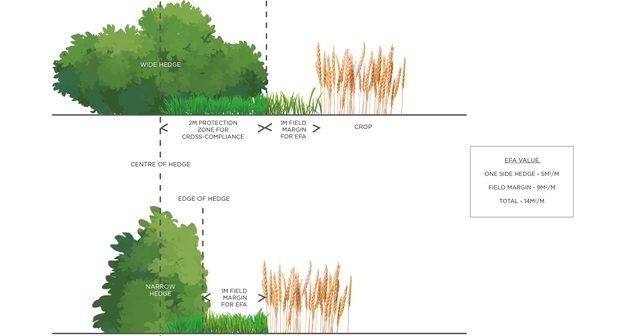Farmers are advised to start the process of measuring and mapping any features they intend to use to meet their 2018 Ecological Focus Areas (EFA) obligations to avoid falling foul of greening rule changes.
Growers should start thinking about how they will complete their 2018 Basic Payment Scheme applications now, rather than leave it until the final few weeks before the May 15 deadline, according to Strutt & Parker.
“The changes around the ban on the use of plant protection products on nitrogen fixing crops and fallow have been well publicised,” said George Badger, farm consultant with Strutt & Parker. “However, DEFRA has recently confirmed some additional changes to greening rules which growers will need also need to consider.
“These include a ban on cultivating fallow land for weed control which could be a blow for those farmers who had been hoping to utilise whole-field fallow to help control blackgrass. It means there is a now a good chance that any germinated blackgrass plants will have set seed before a cultivation or glyphosate can be used on 1 July.”
It is anticipated that many farmers will be looking to use hedgerows, buffer strips and field margins in order to meet their EFA requirement.
However, it is vital that farmers are clear on the eligibility of each of the different options and measure them correctly – or they could face penalties when their BPS claim is processed.
For example, hedges used as EFA must be located on, or within five metres of, arable land and of a continuous length of more than 20m.
In terms of weighting, each side of the hedge is worth 5m2 per metre of hedge – so if a farmer is able to claim both sides of the hedge then 1,000m of hedge equates to 1 ha of EFA.
“Checking the eligibility of hedges may be a challenge for people who have traditionally used peas and beans to meet their EFA obligation,” said Mr Badger. “
“This is why it is best to start the exercise sooner rather than later and to consider how the different options can be mixed to best effect. There is good news in that the Rural Payments Agency has promised that it is introducing a ‘hedge layer’ to Rural Payments online which should map the location and length of hedges and also specify whether they are EFA eligible. However, this information will need to be checked carefully.”
He added: “A positive change to the greening rules, is also the introduction of the new field margin option, which been given a much higher weighting than options such as catch and cover crops.
“Field margins are a 1m strip of uncultivated land adjacent to a bank, hedge, fence or road. It differs to a buffer strip in that it does not need to be next to a watercourse.
“This means farmers who establish an uncultivated strip next to a hedge should be able to claim 5m2 for one side of the hedge and an additional 9m2 for the field margin. The field margin strip can be located on the same area as the 2m cross-compliance protection zone, but there must be at least 1m of uncultivated land from the edge of the hedge to be eligible. This means if hedges are particularly wide then it will be necessary to leave an extra metre to ensure the EFA margin extends at least 1m from the hedge’s edge.
“A key message is that most farms should find it fairly straightforward to meet their EFA obligation if they have a healthy balance of hedges and watercourses, and leave some land uncultivated to claim as a field margin. For example, a 200 ha arable farm with an average field size of 8ha will be able to satisfy their 10ha EFA requirement with 7.15km of one-sided hedgerow with an adjacent field margin. This is approximately a quarter of the estimated field perimeter they are likely to have at their disposal.”
“If in doubt, seek professional advice to confirm the eligibility of EFA features and for guidance in how they should be managed over the coming months.”




